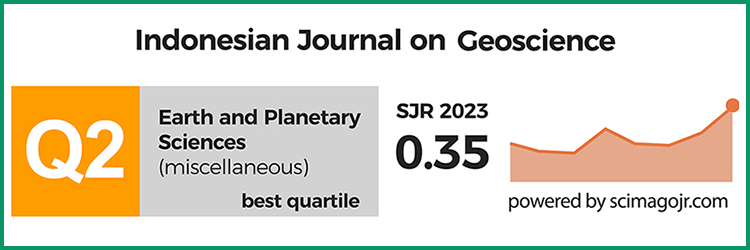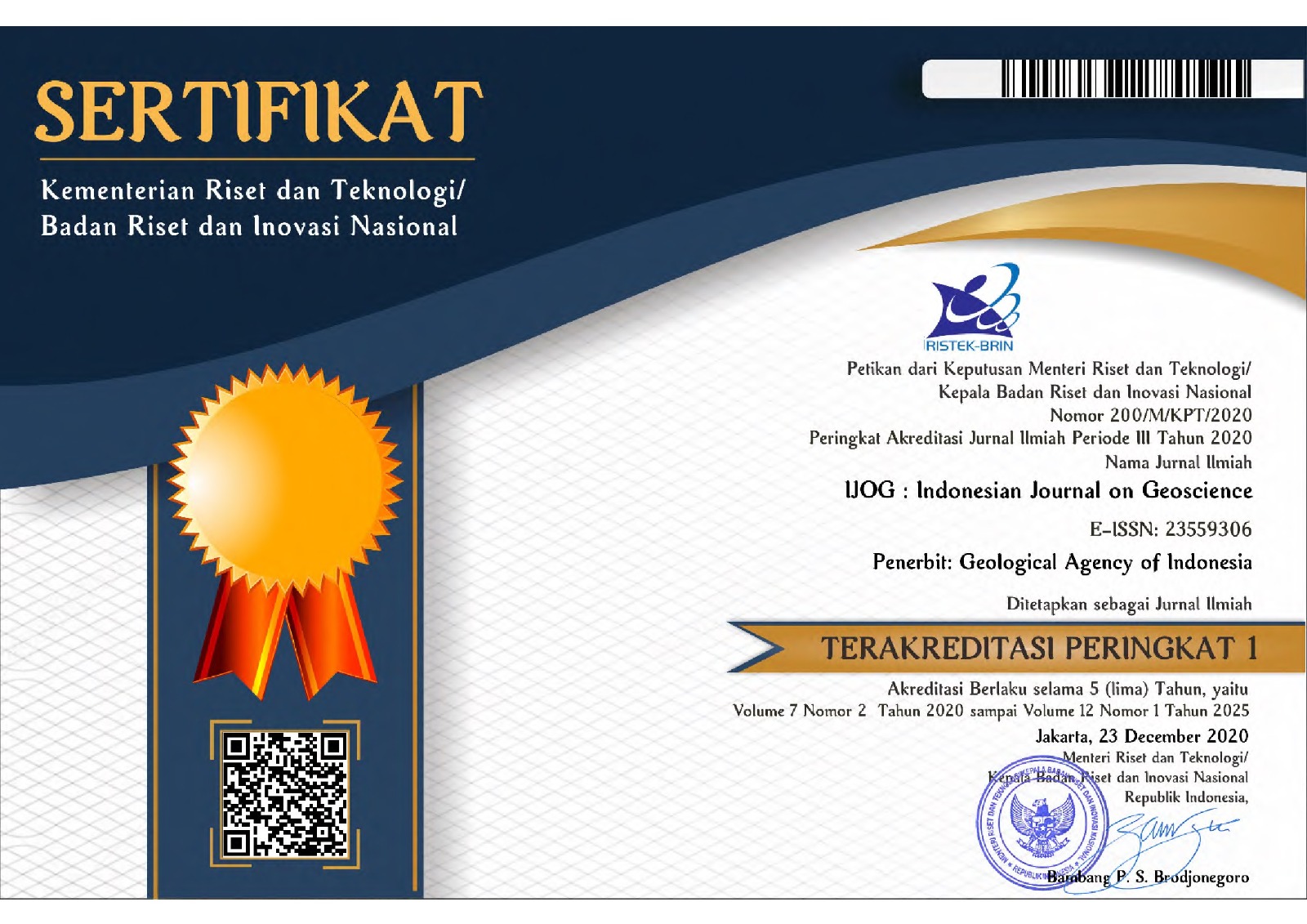Thermal and Infrared Studies of Garnierite from the Soroako Nickeliferous Laterite Deposit, Sulawesi, Indonesia
DOI:
https://doi.org/10.17014/ijog.7.2.77-85Keywords:
infrared, thermal analysis, kerolite, sepioliteAbstract
Mineralogical characterization of some garnierite samples from Soroako have been conducted using X-ray diffraction, thermal analysis, and infrared spectroscopy methods. XRD patterns reveal the samples mainly containing the mixture of kerolite (talc-like phase) and serpentine with minor smectite, sepiolite, and silica. Thermal analyses of garnierite samples indicated by DTA curves are in good agreement with patterns that have been reported in literature. Three endothermic peaks normally occur in the ranges between 58º C and <800º C illustrating three steps of weight losses: adsorbed, bound, and hydroxyl/crystal water. One additional weight loss in low temperature region of sepiolite is corresponding to the lost of zeolitic water. Infrared spectra appeared in 3800 - 3200 cm-1 region generally exhibit broad absorption bands, indicating low crystallinities of studied samples and can be assigned to the presence of hydroxyl group bonded to octahedral coordination mainly Mg atom. The bands observed at 1660 cm-1, 1639 cm-1, 1637 cm-1, and 1633 cm-1 in all samples indicate water molecules. FTIR spectra displaying the strong bands at 1045 cm-1, 1038 cm-1, and 1036 cm-1 could be related to the presence of Si-O-Si bonds linking to tetrahedral coordination. The strong absorption bands appeared at 511 cm-1, 505 cm-1, 499 cm-1, and 496 cm-1 in respective samples are attributed to divalent cation bonds (e.g. Mg, Ni-O). Both TG/DTA and FTIR seem to be the powerful tool in diagnosing the crystal chemistry of garnierite which is mainly composed of phyllosilicate minerals.
References
Brindley, G.W., and Hang, Pham, Thi., 1973. The Nature of Garnierites - I: Structures, Chemical Compositions and Color Characteristic. Clays and Clay Minerals, 21, p.27-40. doi:10.1346/ccmn.1973.0210106
Brindley, G.W., and Maksimovic, Z., 1974. The Nature and Nomenclature of Hydrous Nickel-Containing Silicates. Clay Minerals, 10, p.271-277. doi:10.1180/claymin.1974.010.4.05
Brindley, G.W., Bish, D.L., and Wan, H.M., 1977. The nature of kerolite, its relation to talc and stevensite. Mineralogical Magazine, 41, p.443-452. doi:10.1180/minmag.1977.041.320.04
Brindley, G.W., Bish, D.L., Wan, H.M., 1979. Composition, structures, and properties of nickel-containing minerals in the kerolite-pimelite series. American Mineralogist, 64, p.615-625.
Faust, G.T., 1966. The hydrous magnesium silicates- the garnierite group. American Mineralogist, 51, p.279 - 298.
Frost, R.L., Locos, O.B., Ruan, H., Kloproge, J.T., 2001. Near-infrared and mid-infrared spectroscopic study of sepiolites and palygorskite. Vibrational Spectroscopy, 27, p.1-13. doi:10.1016/S0924-2031(01)00110-2
Frost, R.L and Ding, Z., 2003. Controlled rate thermal analysis and differential scanning calorimetry of sepiolites and palygorskites. Thermochimica Acta, 397, p.119-128. doi:10.1016/S0040-6031(02)00228-9
Fuchs, Y., Linares, J., Mellini, M., 1998. Mossbauer and infrared spectrometry of lizardite-1T from Monte Fico, Elba. Physics and Chemistry of Minerals, 26, p.111-115. doi:10.1007/s002690050167
Jones, B.F. and Galan, E., 1988. Palygorskite-sepiolite. In: Bailey, S.W. (ed.), Hydrous Phyllosilicates (Exclusive of Micas). Review in Mineralogy, Mineralogical Society of America, 19, p.631-673.
Karakaya, N., Celik Karakaya, M., Temel, A., Kupeli, S., and Tunoglu, C., 2004. Mineralogical and chemical characterization of sepiolite occurrences at Karapinar (Konia Basin, Turkey). Clay and Clay Minerals, 52, p.495-509. doi:10.1346/CCMN.2004.0520410
Mitrovic, M., Dojcinovict, M., Vucelic, D., Simic, D., and Martic, M., 1999. Sepiolite - An important mineral for industry and environmental protection. Bulletin of the Chemists and Technologists of Macedonia, 18 ( 2), p.101-115.
Nagata, H., Shimoda, S., Sudo, T., 1974. On the dehydration bound of sepiolite. Clay and Clays Minerals, 22, p.285-293. doi:10.1346/ccmn.1974.0220310
Onal, M., Y. H., and Sarikaya, Y., 2008. Some physicochemical properties of the white sepiolite known as pipestone from Eskisehir, Turkey. Clay and Clay Minerals, 56, p.511-519.
Pelletier, B., 1996. Serpentine in nickel silicate ore from New Caledonia. AusIMM Publication Series, p.197-205.
Post, J.E., Bish, D.L., and Heaney, P.J., 2007. Synchrotron powder X-ray diffraction study of the structure and dehydration behavior of sepiolite. American Mineralogist, 92, p.91-97. doi:10.2138/am.2007.2134
Proenza, J.A, Lewis, F.J, Gali, S., Tauler, E., Labrador, M., Melgarejo, J.C., Longo, F., and Bloise, G., 2008. Garnierite mineralization from Falcondo Ni-laterite deposits (Dominican Republic). Macla, 9.
Springer, G., 1974. Compositional and structural variation in garnierites. Canadian Mineralogist, 12, p.381-388.
Sufriadin, Ueno, S., Imai A., Idurs, A., Pramumijoyo, S., and Warmada I. W., 2010. Characteristics and the occurrence of garnierite from the Soroako nickeliferous laterite deposits, Sulawesi. Proceedings, The 39th IAGI Annual Convention and Exhibition, Lombok.
Tauler, E., Proenza, J.A., Gali, S., Lewis, J.F., Labrador, M., Garcia Romero, E., Suarez, M., Longo, F., and Bloise, B., 2009. Ni-sepiolite-falcondoite in garnierite mineralization from the Falcondo Ni-laterite deposit, Dominican Republic. Clay Minerals, 44, p.435-454. doi:10.1180/claymin.2009.044.4.435
Vitti, C., 2010. Serpentine minerals discrimination by thermal analysis. American Mineralogist, 95, p.631-638. doi:10.2138/am.2010.3366
Wells, M.A., Ramanaidou, E.R., Verral, M., and Tessarolo, C., 2009. Mineralogy and crystal chemistry of “garnierites” in the Goro lateritic nickel deposit, New Caledonia. European Journal of Mineralogy, 21, p.467-483. doi:10.1127/0935-1221/2009/0021-1910
Wesolowsky, M., 1984. Thermal decomposition of talc: A review. Thermochemica Acta, 78, p.395-421. doi:10.1016/0040-6031(84)87165-8



















